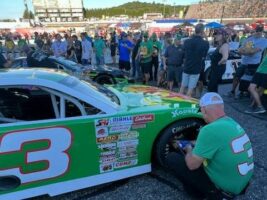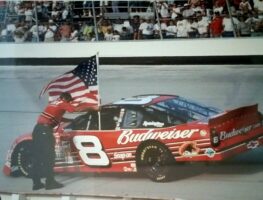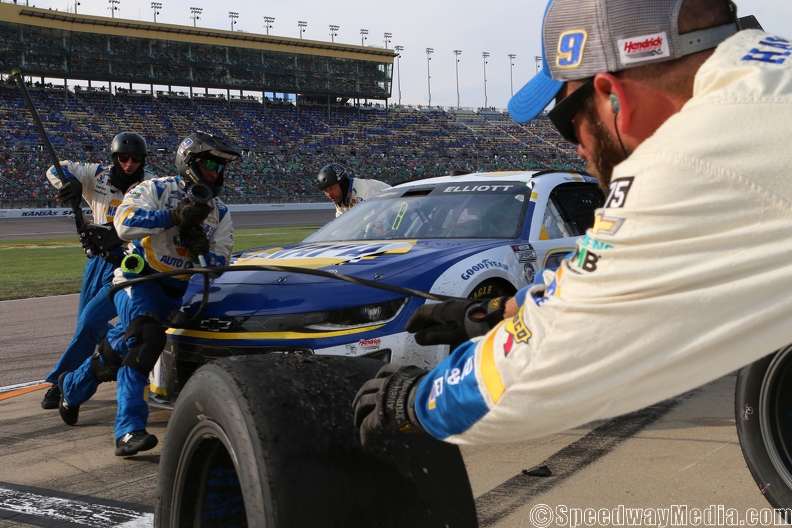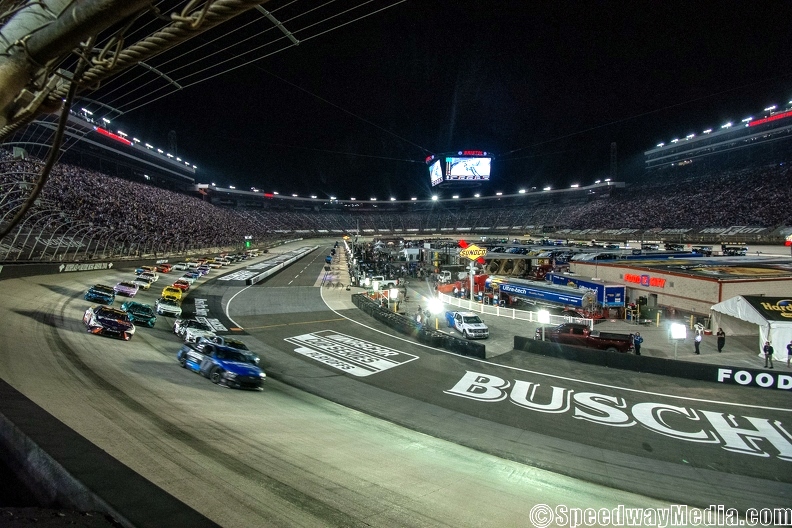Joey Meier is best known today as the pilot for Dale Earnhardt Jr. but his journey into the NASCAR world began as a child. He was raised in a racing family in Marathon, Florida, where his dad, Freddy, raced on the beaches of Daytona and then famously qualified for the final race held on Daytona Beach in 1958.
Growing up, Meier used to work on cars and quite often went to Hialeah Speedway and Punta Gorda Speedway in the West Hollywood Florida area in Lee County. Racing was always in his life but flying wasn’t. He even raced street stocks and won a race but always thought he would be a better mechanic than a driver. Later in his career, he utilized that skill to help a driver and crew chief with feedback during a race.
MW: How did you get into flying?
JM: I graduated high school on a Wednesday and the following Saturday after I graduated, my mom was in an airplane accident. She was with her boyfriend at the time in some type of general aviation – amphibious type airplane, and they were messing around, and they were involved in a very bad wreck. She survived but was never the same. She had broken her neck in several spots but she regained some mobility. I was at the speedway and I got called to go to the hospital.
But because of that accident, and I didn’t even know what kind of airplane she crashed in, it immediately sucked me into aviation. But I never thought I was smart enough to be a doctor, a lawyer, or a pilot. And so it was never in my reach. That was my thought process.
But at the end of her recovery, I found myself very invested in the aviation world. I took pilot lessons and got my initial pilot’s license and I didn’t have a direction on the aviation side.
So, I actually went back to aviation maintenance for two and a half years. I still really didn’t have a direction but my great uncle was an airline pilot and he allowed me to pursue a part of the flying side as far as being a mechanic. I was still young, not quite twenty years old. So once I realized that I could take my love and passion for racing and pursue it via an aviation entrance, that’s where it all began.
And ever since then I’ve gone on to fly charter cargo maintenance and went to work in the airlines for five years. But the entire time I was doing that, I was pursuing a job with Dale Earnhardt.
So my future boss at the time, Mike Collier, it just happened to work out that in 1997 when they expanded their flight department with Dale, they called one day and asked, ‘Are you still interested?’ I said, ‘Yep’ and I was in his office two weeks later and started at DEI.
MW: After your final season, with Brad Keselowski, how and when did you have this conversation with Dale Jr. about becoming his pilot, the opportunities it would bring, and what it would require?
JM: Midway through 2018 as drivers do, they were looking to make a change. Brad wanted to take me off the roof to pursue a different direction in his flight department and in his spotting department. So after multiple conversations in which I didn’t want to come off the roof, we agreed to step away from the spotting and flying side at the end of 2018.
But he needed somebody to fill in flying in 2019. So I actually went and I stayed at Penske from a spotter standpoint and spotted the Wood Brothers car in 2019 and did a little bit of flying for Brad. But then also flew for Victory Air which is another race organization that just does aviation for race teams that don’t have their own flight department. So I spotted the Wood Brothers and flew for Brad, a little bit and Victory Air a little bit and that got me through the end of August in 2019.
Dale had an event occur in Bristol in 2019 that changed the direction of his flight department and opened up an opportunity for employment right away, and as they were searching for someone to take a place that was opening. I was involved in those conversations of if I knew of anybody and it was a perfect opportunity for me to change directions and what I felt was a better course in my life and I went to work for him in December of 2019.
MW: I’ve talked to a couple of people that have actually flown with you and they’ve said that you have kind of like a signature move?
JM: What we used to do and I don’t do it anymore because we haven’t really experienced the opportunity to, but, back in the day, whenever we went to race, we would do a victory lap before we took off. And what that consisted of was on the ground before you took off, you would actually ask (and most of your Towers would allow it) to simply do a Victory 360 on the runway and make an announcement, “Hey congratulations,” kind of like what you would do with the race car. You go around in circles with your hand out in the air.
So that’s what we’re doing with the airplane and it seems to be what all the guys are now doing. So, if you have an opportunity to get on a flight where the team has won, a lot of the pilots will still do the 360, but it’s on the ground. I don’t know if it’s a signature move but, I definitely was one of the first that did it to celebrate whenever we’d win a race.
MW: What’s the difference between your communication while flying and while spotting?
JM: The difference with me from a flying standpoint as you got to remember in flying, you only have one radio and there might be 20 aircraft on the same radio, so I don’t want to say a lot of words. But I want to be very concise with what word I say. That one word will convey a very large message. So I want to be on the radio as short as I can and I transferred that over to the spotting so we could get in these different styles of techniques years ago.
Plate racing is where the word energy came from and it was very successful at the time. And now that word has gone. It’s taken on its own little life but, I never wanted to spot as much as I like talking clearly, I always wanted to try to keep my words in my messages as short as possible, while trying to convey, a very large message with the least amount of words possible
MW: I was going to ask if you ever watch from the roof, and if so, has it ever made you want to get back into spotting?
JM: This year I’m going to have an opportunity to spot for my current boss as he runs a couple of Xfinity races. He’ll be running at Bristol and Homestead. Also, I’ll be spotting for Carson Kvapil during his truck debut at Bristol and I’m looking forward to that immensely. (Meier also filled in for T.J Majors while he was out sick recently).
Also, I was fortunate enough last year as a lot of the truck teams were looking for spotters and I was fortunate enough that the KVM Truck team with John Hunter called and I was able to spot in Knoxville with him. We had an amazing amount of fun. And then at the same time, Ryan Blaney’s spotter, Josh Williams had a chance to run a modified race at Caraway, and I went up and spotted him and we had a really good time.
And that made me realize that I do miss it. I enjoy it thoroughly. I’ll also travel with Dale on The Late Model side whenever he does a Late Model race. It’s kind of a volunteer group of guys because we don’t race full-time. We’ve raced in North Wilkesboro and Florence. And we did that a couple of times this year.

I’ll also travel with Dale on The Late Model side whenever he does away a Late Model race. It’s kind of a volunteer group of guys because we don’t race full-time. We’ve raced in North Wilkesboro and Florence. And we did that a couple of times this year.
MW: Is there anything that you and Dale do together, particularly outside of racing?
JM: No, it’s definitely a working relationship and that’s fantastic. We text quite a bit back and forth when we’re not working together, relative to whatever it might be, you know. As long as it continues that way because we have a good working relationship, I hope I can keep doing that.
MW: With you having all of this valuable knowledge and experience, has it ever crossed your mind to enter the booth or be a Pit Road commentator at any point?
JM: You know, back in 2013 MRN was gracious enough to put myself and the team up with Woody Cain and we had our own podcast. It ran for nine years. I thought we had a lot of good times. We were under the MRN Banner in which we had some guidelines. If an opportunity presents itself, I’ll tell you who does a really good job nowadays and I would love to do it and wish I could have been in that spot but Coleman Presley has been approached by Fox and does some TV from the roof from the spotter’s viewpoint.
I think that’s wonderful. I’ve always said that I thought that in the future and I was clearly wrong, but I always thought there’d be crew chiefs from the roof because you see a much bigger picture. Now, one of the reasons I’m wrong is because technology has brought all that information to the computer tables in their pit boxes. So they don’t need to be on the roof anymore to see what the spotter sees. But it’s still a good viewpoint.
Visually obviously, the spotters will always stay on the roof. But Coleman does a really good job. And if that opportunity ever presented itself, I’d love to do it. I do miss being at the racetrack. Now, I’m not going to risk or entertain moving on from the position I’m in now, because this is something I hope I can stay for the next 10, or 20 years doing. As I know, it sounds, a long way away but. my health is virtually perfect.
MW: What do you do while Dale’s working?
JM: Melissa, that’s a good question because now that I’m not involved in racing, there’s no need for us to stay with the race team, right? So the flight department has its own budget and our requirements are to try to be as efficient as possible. If you’re traveling as much as I do; you know that the closer to the racetrack/airport, you get, the more expensive your hotels are. All right, so we don’t need to be there. I don’t need to be close to a racetrack or close to the airport. I land and I can drive. For instance: I can go north from Daytona or north from Homestead or wherever I have to go to get what’s a little more efficient for our hotel needs. So I do that and we’ll get in a car and we’ll drive
40, 50 miles up north. This is also allowing me to enjoy one of my greater hobbies that I enjoy away from racing and that’s bowling. And what I do is – I carry a set of bowling balls with me in the airplane. Actually, I carry three with me wherever I go. And I do a lot of tournaments on the road, or I just do some open bowling and practicing or some tournaments. And I’ve had the luck to run into some good people around the U.S., and I’ve actually taken some instruction which I did down in Daytona in March, which was really cool, but allows me to bowl because I’m a bowling fool. I work to support my bowling habit.
MW: Is there anything on your bucket list you have yet to achieve?
JM: Professionally, all I’ve ever wanted to do is my job. Hopefully, I can carry this off into the sunset. My bucket list is to able to finish that out. Personally, I’ve got two wonderful kids. One’s in the Navy and one’s a manager at Celsius Manufacturing. They’re just now starting their lives right there just getting into their 30s. Believe it or not, I’ve got two wonderful grandkids, and as a grandfather supporting them is a very unique experience and I’m looking forward to continually experiencing things in life with my wife, kids, grandkid, and our dogs. I don’t really have a bucket list, I just want this ride to continue on.
I’d like to personally thank my friend, Joey Meier for this interview as I’m grateful for the many opportunities we’ve had over the years to chat about racing and flying.
Joey Meier hands Dale Earnhardt Jr. the American Flag at Dover Motor Speedway after 9/11.








